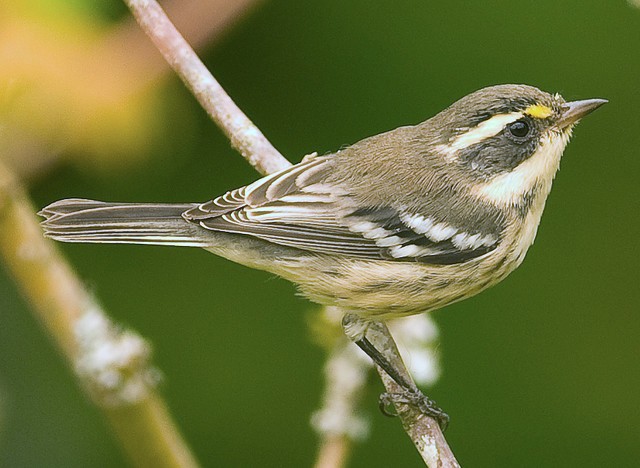Black-throated Grey Warbler
A species of Setophaga Warblers Scientific name : Setophaga nigrescens Genus : Setophaga Warblers
Black-throated Grey Warbler, A species of Setophaga Warblers
Botanical name: Setophaga nigrescens
Genus: Setophaga Warblers
Content
Description General Info
Description
The black-throated gray warbler has mostly black, gray, and white plumage, which is soft, lacking gloss. With its striping and the small yellow spot between its eye and bill, it is a distinctive bird. The sexes differ slightly, both having gray upperparts with black streaks, and white underparts with black streaks on the flanks. The adult male is striped with a black on the crown, throat, and below the eye, and has white around its chin and above its eye. The adult female has more dingy plumage on its head, with a white throat and dark gray cheeks. The most similar birds to the black-throated gray warbler are the black-and-white and blackpoll warblers, which although marked in black have entirely different plumage patterns. It is typically 13 cm (5.1 in) long, weighing 8.4 g (0.30 oz). Wing lengths are 5.6–6.9 cm (2.2–2.7 in), tail lengths 4.7–5.5 cm (1.9–2.2 in), bill lengths 8.4–9.6 mm (0.33–0.38 in), and tarsus lengths 1.66–1.88 cm (0.65–0.74 in), with females slightly smaller than males. Wingspan ranges from 7.5-7.8 in (19-19.7 cm). This bird gives a sharp tup or thick call, like that of Townsend's warbler but flat and unmusical, as well as a high see flight call. The male's song is a series of buzzy notes, with the earlier notes doubled and the next to last note high. This song has three variations, including a quiet "soft song" given by the males while following females gathering material for a nest. 
Size
12-13 cm (4.75-5 in)
Nest Placement
Tree
Clutch Size
3 - 5 eggs
Incubation Period
1 - 2 broods
Feeding Habits
Black-throated Grey Warbler predominantly consume insects, foraging mainly in the lower to middle forest strata. They exhibit slow, deliberate hopping movements as they search for prey on trees and shrubs.
Habitat
Black-throated Grey Warbler typically inhabits open pine forests, pine-oak woodlands, and pinyon-juniper forests with a dense brushy understory. It thrives at various altitudes, preferring regions with mature conifers and mixed coniferous-deciduous environments. These birds are also found in chaparral, oak scrub, and low ridges with open juniper stands. During migration, black-throated Grey Warbler frequents similar habitats including woodlands, scrub, and thickets, indicating a consistent preference for semi-open areas rich in vegetation.
Nest Behavior
Females of the black-throated Grey Warbler species carefully construct the nest and line it with feathers. They exhibit precise egg-laying patterns and, along with the males, engage in diligent parental care for their eggs and young.
Nest Characteristics
The black-throated Grey Warbler weaves its nest using bark, grasses, and mosses into a deep, bulky cup, lined with feathers, situated on a horizontal branch or fork, typically in firs, oaks, or pinyon pines, 3 to 35 feet above ground.
Dite type
Insectivorous
General Info
Feeding Habits
Bird food type
Bird Feeder Type

Small Hopper

Small Tube Feeder
Sounds
Call
Recording location: Mexico
Behavior
Black-throated Grey Warbler exhibit patience as they forage, methodically hopping across branches in lower to middle stratums of open coniferous woodlands, carefully scrutinizing for caterpillars. During breeding, mated pairs bond, with males vigorously defending territories through melodic buzzes and pursuing intruders. Post-breeding, these warblers adapt socially, integrating into mixed flocks for migration and wintering, a testament to their gregarious nature during non-breeding periods. Remarkably, black-throated Grey Warbler also experience nest parasitism, often unwittingly nurturing Brown-headed Cowbird chicks due to deceptive egg-laying practices by the latter.
Distribution Area
The black-throated gray warbler breeds in western North America, its range extending from southwestern British Columbia along the Pacific coast to northern Baja California, and east to New Mexico and southern Montana. It winters mostly in Mexico, from southern Baja California to Oaxaca state. It has spread into parts of Wyoming and Montana only recently, as Juniperus osteosperma has expanded its range due to a warming climate. Vagrants have been recorded across eastern North America and in Cuba. The black-throated gray warbler breeds in open coniferous and mixed forest with a brushy understory, in dry open oak forests, and in chaparral and other scrubland. It is particularly associated with pinyon pines, junipers, and oaks. It migrates to the south late in the fall, returning north in mid-spring. While migrating, it forages in any woodland or scrub it passes through. In its wintering grounds, it occurs in dry woodland and tall scrub. Though its status is not well known, it does not appear to be seriously threatened by habitat destruction or other human activities, unlike many migratory warblers. It is a fairly common bird, among the most common in some localities. Because it is common and not in rapid decline, it is assessed as Least Concern on the IUCN Red List. 
Species Status
Not globally threatened.
Scientific Classification
Phylum
Chordates Class
Birds Order
Perching birds Family
New world warblers Genus
Setophaga Warblers Species
Black-throated Grey Warbler 